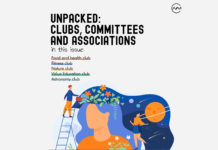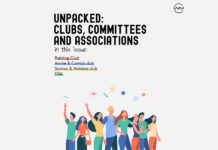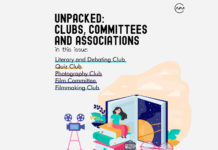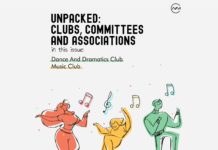In the final instalment of the series, we’ll be looking at the eight branch associations of the college. They are Electronics and Communication Engineering Association (ECEA), Civil Engineering Association (CEA), Technical Association of Biotechnology (TAB), Computer Science Engineering Association (CSEA), Mechanical Engineering Association (MEA), Electrical Engineering Association (EEA), Metallurgical and Materials Engineering Association (MMEA) and Indian Institute of Metals-Student Chapter (IIM-SC), Chemical Engineering Association (ChEA) and Indian Institute of Chemical Engineers-Student Chapter(IIChE-SC).
ECEA
Having conducted one of the most successful events of the year- Techflix’20, ECE Association went from less than 10 events in 2018-19 to 60+ topnotch events in 2019-20. Their ability to cook up an event from the weirdest idea and their zest for taking up challenges is what sets them apart. Ideation is their most crucial phase followed by selecting the perfect organizing team. Publicity and preparing the content to be delivered are other factors that ensure their event’s success. Their major events include Workshops (Verilog, IoT, Photoshop and Video Editing), Apprenticeship, Code-Quest, Mock Placement and Internship, Placement and Internship Experience Series.
The GenSec and AdSecs, selected by the faculty advisor based on their experience, select the JointSecs and Exec Members. The interview process for the existing members is based on their work experience. The new applicants are judged on skills like poster designing, content writing, publicity (situation based questions), event management and creativity (event ideas). The work divisions consist of Design, Content Writing, Social Media, Web Development, Event Planning and Conduction. The online sem interviews were majorly based on google doc responses along with a small assignment for every shortlisted applicant. They’ve recruited designers and content writers who are also technically strong, thus making online content publishing their priority.
CEA
Formed in the early 2000s, CEA is one of the oldest associations of NITW. It was formed by a group of students who wanted to encourage technological innovation, dialogue and awareness in the field of civil engineering. CEA has been providing practical exposure through regular activities. For events to be successful, they start planning at least a week before to be well-prepared. The Event Managers first conceptualize and publicize and then conduct and host. The Event Managers, Logistics team, Content Writers and Designers work together to yield good results. Some of their major events are Civil Student Seminar, Gram Parivarthan, Tensegrity, Sandtower Competition and Online Mock tests (GATE, Aptitude, Academic-for placements). Apart from these, one of the highlights of the association is their monthly newsletter.
The process of selection is done based on applications and interviews. However, for the first-year Btech students, the selection happens during the freshers’ event which consists of two rounds (JAM and Interview). The team is selected based on creativity, enthusiasm, willingness to learn and skill. They are sorted into 6 different divisions based on their interests- Event Management, Collaboration, Logistics, Social Media, Photography and Designing, Content Writing and Editing. Each team is led by one or more secretaries. Executive members spend their time learning and enhancing their skills. The second and third years play a major role in conducting the events, writing content and designing. They see the online sem as a challenge rather than an obstacle. They are working on making their events more informative and creative than before.
TAB
At TAB, it is believed that they are ‘of the people, by the people and for the people’. Hence all their activities are intended to help the department students grow as better professionals. They consistently remain active to achieve the same and keep the students engaged. Hours of brainstorming for a unique event followed by a checklist of various responsibilities which is then run by the team members is what makes their event successful. They are the first association to have an active alumni community- BioNITWork. As a team, they function to conduct events in three major categories, which are, Technical events comprising of quizzes, weekly articles, poster presentations, workshops and webinars; Non-technical events comprising of profile building session and other general events; lastly outreach events including interactive sessions with alumni, other biotech associations, start-ups and professors.
The executive body is selected by the faculty advisor. A balance between ideas and the zeal to consistently work is what they look for. A major drawback of work-based divisions is that not everyone in the association knows where their strengths lie, especially with the freshers and second years. Hence, this year the entire team is segregated into four sub-teams of eight members each, pretty much like the four types of DNA nucleotides AGTC! And they work sequentially. This way all the members are working and everyone gets to try hands at poster designing, event managing, content writing and publicity. With the right skills and management, working online is not an issue for them.
CSEA
Formed in 2002 with the intention of conducting various events to keep students engaged, CSEA is a bunch of dedicated students who work as a team to help students across all branches. The core of CSEA lies in the continual effort to be innovative and impactful. It paid off when they bagged the title of Best Association for two consecutive years.
After brainstorming and finalizing the idea, work is divided among all the internal departments and teams leads are decided upon. There are checkpoints for each department so that the progress can be measured. Some of their major events are Department Freshers and ‘Know Your Branch’ for the freshers, Valar Doubtulis and DS sessions for concept clarification, Devathon, workshops like AI and Web Development, resume building workshops and Mock Intern Drives.
Starting with a detailed questionnaire and moving on to interviews taken by the FacAd and final years, the selection process is pretty thorough. Qualities like teamwork, commitment, experience, technical and non-technical skills are what they look for. Under the guidance of the GenSec and AdSecs, 3rd years take the lead of various teams. 2nd years get complete freedom to join the team of their choice and contribute. To ensure a smooth workflow, there are internal departments like Design, ECC, PR, QCM and Quiz. Members can be part of any team they wish to join. When an event is finalized, work is divided and a collective effort makes the event successful. Online sem comes with its own set of challenges but they have adapted to this new normal and strive to curate content that stays relevant.
MEA
MEA, the oldest association of NITW, believes that being unique is better than being perfect. They conduct a variety of events involving fun, literature and social awareness in addition to technical ones. They have sessions by professors to help students stay motivated and optimistic. They focus on the all-round development of students and the team. Some of their major events are Meshers and ‘Know Your Branch’ for the freshers, sports week, technical workshops like MATLAB, Solidworks, CATIA, Ansys, and fest events like Contraption, Armageddon and Junkyard Wars. The entire team helps in ideation. A sub-team is then formed for each event.
The team is selected based on interviews. GenSec and AdSecs are selected by faculty, who then choose the JointSecs and Exec Members. They primarily look for passion and determination. They also look for interpersonal and technical skills and skills like Event management, Content writing and Graphic designing. Final years guide the juniors and make sure things are on track. Third years plan, supervise and conduct the events. Second years help in execution and publicity of events. Event management is done by members allotted for a particular event. The content writers are responsible for event publicity, newsletters, series like ‘Factly’ etc. The designers are in charge of posters and making videos. Members also handle social media platforms. They have shifted online to organize meetings and events, and they have made the most of it by using platforms like discord for recreation and gaming events.
EEA
EEA encourages a system with no walls and a diverse flow of ideas. Members are encouraged to speak their mind, disagree with an idea and present their opinion. They appreciate all the effort that goes in. Every idea put forward as an event proposal is discussed thoroughly and a rough draft is prepared. Once it gets accepted by the faculty advisor, a proper date is decided. Active feedback is taken from students both in and out of EEA to improve on event conduction. Every member takes an active part in the entire process. Some of their events include the workshop series for Matlab, Simulink and web development, poster presentation, quizzes conducted on different topics, alumni connect, mock OTs and drives, placement and intern talks. To bridge the gap between faculty and students, they plan on restarting events like ‘Free time with faculty’.
The executive body is formed by the faculty. They interview students around various aspects from leadership skills to academics. One of the qualities they look for is teamwork and time management. Work is divided and events are planned with a lot of enthusiasm. Because of the online sem, there are only 4 main work divisions- writeup, poster making and video editing, technical and event coordination. Events like the treasure hunt had to be postponed or cancelled due to online sem, but they have come up with amazing event ideas.
MMEA and IIM-SC
The uniqueness of MMEA and IIM-SC is that the work done and events conducted based on MME domain knowledge help other branches as well. They conduct events after analysing every detail thoroughly and rectifying the mistakes committed before. They pride themselves in taking opinions from all the association members so that they come up with creative ideas that have minimum error. Some of their major events include PPT presentations on solutions concerning industrial problems, Intern Talks, Works shops, Additive Manufacturing, Metallography contests and Quiz Contests. The executive body is selected through interviews of interested candidates. They mainly look for enthusiasm, interest and commitment towards their work. They also look for applicants who can come up with innovative ideas to help their peers through the association. The members are divided into Content Writers, Editors and Graphic designers, Photographers, Logistics and Social media Marketing.
ChEA and IIChE-SC
ChEA and IIChE is a small group of people with big goals who are always willing to give their 100%. They provide exposure and unveil fascinating opportunities in chemical engineering. IIChE is the professional body for Chemical Engineers in India. They have Student Chapters in various colleges and NITW is one of them. A successful event requires planning well before the event date. An event showcases the team’s effort, competence and experience in event coordination and conduction. Right from great publicity to smooth conduction, they handle everything. Both ChEA and IIChE-SC work alongside each other. Placement series, Research insights, mock GDs, mock interviews, Ansys workshop, DWSIM workshop, IIChE membership drive, Alumni interactions, talks related to future opportunities for higher studies, Intern talks, Energy Conservation Week in association with IOCL and sports week are some of their major events. The end of ‘IOCL week’ is marked by a Valedictory Ceremony in which they invite an official from IOCL and distribute prizes.
The executive body is selected by a panel of professors based on a candidate’s potential. A lot of factors including academic performance, participation in association activities, extra-curriculars, activities beyond curriculum and willingness to take initiative are considered. They have different divisions like event coordination, logistics, documentation, treasury and publicity. Each member is actively involved in event publicity. Final years guide third years in event conduction and instil leadership in them. Third years actively conduct events. Second years and first years are often the most enthusiastic ones, always willing to contribute and brainstorm event ideas.





